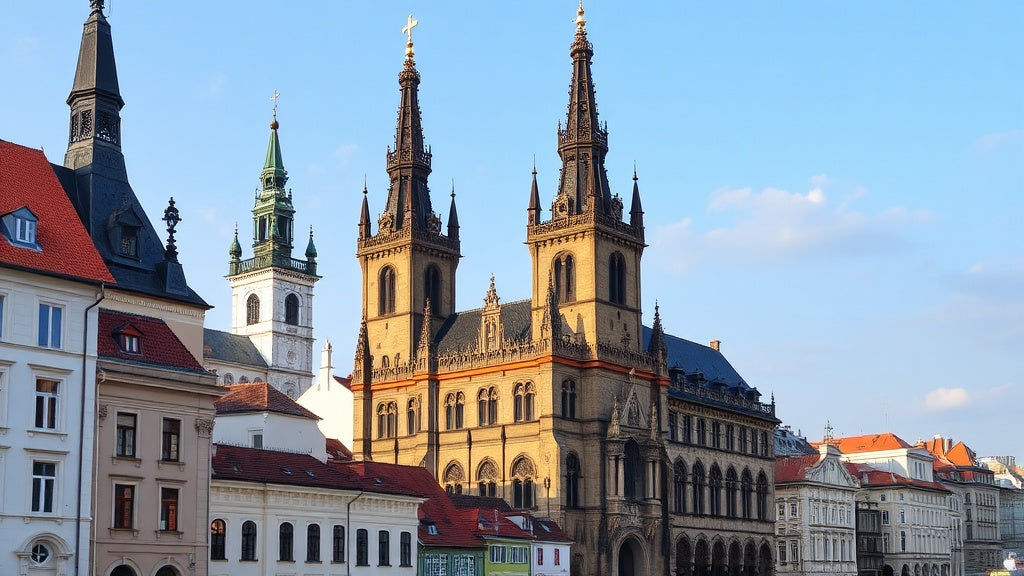
"1945's Final Stand: The Soviet March to Berlin and the Fall of the Third Reich"
, by Unboxify, 15 min reading time

, by Unboxify, 15 min reading time
It is February 1945. Soldiers of the Soviet Eighth Guards Army stand in silence as they observe the rays of the morning sun glisten on the icy waters of the Oder River. Among them is the war correspondent Vasili Grossman. Vasili has covered the war since the Battle of Moscow, and like his comrades in arms, he has counted every river he has crossed since the advance westward from the Volga at Stalingrad. Now, after a hellish trek of over three years, he stands at the bank of the final river before Berlin. Caught by the emotion of the moment, he writes.
By early 1945, Hitler’s Third Reich was on its last legs. While the Allies prepared to make a dash across the Rhine, in the East, the Red Army was advancing toward the German border at lightning speed. As its armies closed in on Berlin, its men vowed to take revenge for the death and destruction the Germans had brought upon the motherland. Hitler, however, would not go down without a fight and forced his defeated people into one more cataclysmic bloodletting that would not end until the hammer and sickle finally flew above the Reichstag, and the Führer lay dead in his underground bunker.
1944 had been nothing short of a disaster for the Germans on the Eastern Front. After the annihilation of Army Group Center, the seemingly unstoppable Red Army had chased the Wehrmacht to the gates of Warsaw. In the south, Romania and Bulgaria had capitulated and changed sides, while Hungary verged on collapse as Soviet armies laid siege to Budapest. Unwilling to admit defeat, Hitler now made the momentous decision to deploy his final armored reserves to relieve the city’s defenders and secure Hungary’s oil fields. This, as it turned out, was exactly what the Soviet High Command, better known as the Stavka, had hoped for.
By increasing pressure on the Hungarian front, Stalin and his advisors aimed to lure the Führer into moving his vital armored reserves away from Poland. Simultaneously, three Soviet fronts totaling some 2.5 million men would make a dash across the Vistula River around Warsaw and drive straight toward Berlin.
To mentally prepare their men for the coming struggle, political commissars handed out instructions that echoed the overwhelming sentiment felt among the embittered Soviet soldiers: “The soldier’s rage in battle must be terrible, he does not merely seek to fight; he must also be the embodiment of the court of his people’s justice.” Fueled by a desire for revenge, Stalin’s armies began breaking out of their bridgeheads on January 12th. Within days, the outgunned defenders were forced into a frenzied retreat.
On January 15th, General Heinz Guderian pleaded with Hitler to send every available unit east. The Führer, in turn, made great promises in the form of two SS Panzer Corps recently withdrawn from the Ardennes. However, rather than arriving to salvage the situation in Poland, they were thrown into yet another one of Hitler’s armored pipe dreams in Hungary. Lacking sufficient mobile reserves, the bulk of the ill-fated German defenders were encircled and destroyed.
As the catastrophe unfolded, Berlin radio broadcasted apocalyptic news bulletins, comparing the advancing Red Army to the Mongol hordes. Driven by fear, a growing mass of German refugees began a long, deadly march across the icy roads leading westward in hopes of eluding the jaws of Soviet vengeance. The dreaded Red Horde, however, was moving at lightning speed, and by the end of January, its armies had advanced some 500 kilometers (311 miles) to the banks of the Oder River, just 60 kilometers (37 miles) from Berlin.
The rapid advance had stretched the Red Army's logistics to their limits, and heavy resistance in East Prussia had left Marshal Georgy Zhukov’s flank dangerously exposed to counter-attack from German troops massing in Pomerania. As a result, the Stavka decided to halt the final assault on Berlin until the flanks were secured. By mid-April, the Red Army had reached the Oder-Neisse River line on a front that stretched from Stettin in the north to the Czech border in the south. The eyes of the world were now converging on Berlin as Stalin’s armies prepared for their final act of vengeance that would eradicate Nazi Germany once and for all.
Although the Allies had promised to leave Berlin to the Red Army, the ever-paranoid Stalin still urged haste in the capture of the city. The final plan called for a three-pronged attack on the Berlin axis to encircle and capture the city within 12 to 15 days, then move on to meet the Allies at the Elbe River. Zhukov’s First Belorussian Front would be at the center of the thrust, while Marshal Ivan Konev’s First Ukrainian Front to the south was set to attack across the Neisse River in the direction of Potsdam and Dresden. Finally, Marshal Konstantin Rokossovsky’s Second Belorussian Front would tie down German forces to the north in the Stettin-Schwedt sector to prevent them from reinforcing Berlin.
Having become accustomed to fighting on wide-open terrain, few in the Red Army had much experience in large-scale urban street fighting. It was up to General Vasili Chuikov’s Eighth Guards Army, veterans of the Battle of Stalingrad, to distribute pamphlets on urban warfare while special combined arms task forces were formed. Red Army engineers worked day and night to construct hundreds of bridges and thousands of wooden assault boats to cross the Oder and Neisse rivers.
To achieve this, Soviet planners had to find a way to move 29 armies over hundreds of kilometers to create shock groups capable of penetrating the German line in areas only 2.5 to 10 kilometers (1.5 to 6 miles) in width. When it was all said and done, the Red Army would advance on Berlin with some 2.5 million men, 6,250 tanks and self-propelled guns, and 7,500 combat aircraft. Aiming to make the invaders bleed for every inch of German soil, the Wehrmacht constructed a series of well-entrenched defensive lines which barricaded the way into Berlin.
On April 12th, the Berlin Philharmonic Orchestra gave its last performance, among the music played was Richard Wagner’s "Ride of the Valkyries." Four days later, another type of orchestra began to play as thousands of Katyusha rocket launchers and field guns of Zhukov’s front opened up on the first German defensive line along the Seelow Heights. Miles away in Berlin’s eastern suburbs, houses began to shake as terrified citizens gathered in the street to listen to the start of the coming storm. A stunned Russian engineer described the unfolding spectacle:
“Along the whole length of the horizon, it was bright as daylight. On the German side, everything was covered with smoke and thick foundations of earth. Clumps were flying up, and there were huge flocks of scared birds flying around in the sky. A constant humming, thunder, explosions… We had to cover our ears to prevent our eardrums from breaking.”
As the sound of artillery gradually faded, hundreds of men began shouting "To Berlin!" as tank engines roared and elite assault elements began advancing toward the heights. Many of the German defenders unfortunate enough to have been caught in the preceding onslaught had disappeared in the blink of an eye. Dazed and panic-stricken survivors rushed back toward the second defensive line.
However, the awesome bombardment obscured serious problems in Zhukov’s plan. The destruction caused by the shelling had severely worsened the condition of the terrain that his men now had to traverse. The searchlights intended to blind the enemy instead reflected onto the smoke-filled air and obscured the vision of the advancing infantry. In the resulting chaos, units lost contact with each other as Soviet artillery and aircraft began attacking friendly formations.
Worse still, German intelligence had prior knowledge of the coming offensive, which meant that many of the first-line troops had been evacuated to the safety of the rear. What ensued was nothing less than what a member of the Großdeutschland guard regiment described as a “slaughterhouse.” Countless soldiers were cut down as they struggled to advance across flood plains and through German minefields.
In other sectors, attackers were repulsed as they attempted to cross the Oder. Sensing disaster, an increasingly agitated Zhukov ordered his two tank armies to attack at once. However, most of the infantry’s artillery and supply vehicles were still trying to make their way to the front, causing the tank armies to become hopelessly stuck in traffic jams.
Even when the lead armor finally approached the heights, they were ambushed by concealed 88 gun emplacements, Tiger I tanks, and infantry armed with deadly Panzerfaust recoilless anti-tank launchers. Decimated, Zhukov’s men had made little progress by the end of the first day. It would take three more days and countless more deaths before his armies finally forced their way through the final defensive line. Stalin was infuriated, but he could rest easy in the fact that Konev’s front to the south had seen more success.
By the end of April 18th, Konev’s tank armies were across the Spree River and racing toward Berlin. Lacking sufficient reinforcements and ammunition, the surviving defenders in both sectors were forced into a headlong retreat. With the German defensive lines in the south and center broken, and with vital troops in the north still tied down in heavy fighting, the road to Berlin lay open.
Lacking the supplies to keep on fighting, German morale began to collapse. Thousands of encircled men surrendered, while masses of stragglers, deserters, and refugees made their way into the doomed city. All the while, an increasingly delusional Hitler continued to demand fanatical resistance until the bitter end.
On April 20th, Hitler’s birthday was rudely interrupted by Soviet artillery shelling Berlin’s northeastern suburbs. As its citizens fled into cellars, Zhukov and Konev’s tank armies began a frantic race to the city’s outskirts. In the meantime, many senior officials of the Nazi Party engaged in a similar type of competition: to be the first to get permission to flee the city.
Soldiers on the ground enjoyed no such privileges. Those who tried to run or displayed signs of cowardice were hanged throughout the city with messages such as “I was a coward” or “I was a deserter” dangling from their chests. The next morning, Soviet artillery fired a frenzied barrage into Berlin’s city center while the remains of General Helmuth Weidling’s 56th Panzer Corps of the German Ninth Army conducted a desperate withdrawal across Berlin’s Autobahn ring, mercilessly strafed by Soviet aircraft.
Other remnants of the German defense attempted in vain to stop Zhukov’s armies from pushing into the city from the southwestern and northern flanks. However, its depleted units could only delay the enemy, and Zhukov and Konev’s forces both reached the city’s outskirts that evening.
Believing himself to be the next Frederick the Great, Hitler remained confident that a massive counter-stroke by the newly created Army Detachment Steiner and the Ninth Army against Zhukov’s flanks would trap the invaders in the city. This would be a ploy similar to what had befallen the Germans at Stalingrad two years prior.
When it became clear the following day that Steiner’s Army Detachment lacked sufficient strength and ammunition to attack, the Führer finally cracked and openly admitted for the first time that all was hopelessly lost. With the Soviets breaking into the city, General Weidling was appointed commander of the Berlin Defense Area. However, by the time Weidling took command, only about 45,000 Wehrmacht and SS troops, just over 40,000 men of the Volkssturm, and a measly 60 fuel-starved tanks were left to defend the city against some 1.5 million Soviet troops.
Unsurprisingly, Zhukov’s armies managed to push the defenders out of the eastern and southeastern suburbs by the end of the 23rd while other fronts tightened their grasp around the city’s flanks. With inevitable defeat looming, many defenders began to lay down their arms. Others, however, continued to resist fanatically.
At the Tempelhof Airport, a mixed group of SS-led German defenders, including about 100 Hitler Youth, wreaked havoc on the attacking Soviet tanks and infantry. The attackers had to resort to massive aerial and artillery bombardment to finally capture the airport a day later. By that time, the encirclement of Berlin had been completed.
However, a manic Hitler promised Weidling that yet another massive counter-offensive by General Walther Wenck’s 12th Army in the southwest was sure to come to the rescue of the beleaguered defenders. Wenck, however, had no intention of embarking on a futile suicide mission and instead moved to relieve encircled German troops further to the east.
With no further hope of relief, Weidling urged the Führer to stage a breakout westward to join up with remnants of Army Group Vistula. Hitler, however, rejected the plan and restated his intention to fall at the head of his troops. During the next three days, the Red Army tightened its hold on Berlin as the advancing armies closed in on the inner defensive line protecting the governmental district.
The lack of clear demarcation lines between the fronts led to various formations competing for space and getting hopelessly confused in the ensuing quagmire. After careful deliberation, it was decided that most of Konev’s frustrated men were to be redeployed to Czechoslovakia while Zhukov would go in for the final kill.
By the end of the 29th, the Eighth Guards Army had blasted its way through the heavily defended Tiergarten sector while the Third Shock Army had crossed the Spree over the Moltke bridge just to the north. In front of them lay the ultimate prize: the blackened walls of the Reichstag, the former parliamentary building widely regarded as the symbolic heart of the Third Reich.
Capturing it would be nothing less than the culmination of the entire Soviet war effort. The defense of the building and its surroundings was led by a determined group of mostly foreign SS fighters with little left to lose. On the morning of the following day, Soviet artillery opened fire as a few hundred assault troops rushed forward.
After a heavy firefight, the men reached the main entrance and proceeded to clear the building in brutal close-quarters combat. Hours of bitter fighting ensued, and the red banner was finally spotted hanging from the second floor at around 2:30 PM. It wouldn’t be until late in the evening before a path to the roof had finally been cleared, allowing the hammer and sickle to be hoisted atop the Reichstag by two sergeants, marking the symbolic end of Hitler’s Third Reich.






